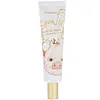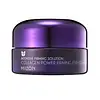What's inside
What's inside
 Key Ingredients
Key Ingredients

 Benefits
Benefits

 Concerns
Concerns

 Ingredients Side-by-side
Ingredients Side-by-side

Swiftlet Nest Extract
Skin ConditioningWater
Skin ConditioningGlycerin
HumectantCetyl Ethylhexanoate
EmollientCetearyl Alcohol
EmollientHelianthus Annuus Seed Oil
EmollientDimethicone
EmollientNiacinamide
SmoothingPentaerythrityl Distearate
EmulsifyingGlyceryl Stearate
EmollientHydrogenated Polyisobutene
Emollient1,2-Hexanediol
Skin ConditioningBehenyl Alcohol
EmollientGlycine Soja Sterols
EmollientHydrogenated Lecithin
EmulsifyingTriethanolamine
BufferingCaprylyl Glycol
EmollientCarbomer
Emulsion StabilisingPolyglyceryl-10 Distearate
EmulsifyingButylene Glycol
HumectantVitis Vinifera Seed Oil
EmollientSimmondsia Chinensis Seed Oil
EmollientMacadamia Ternifolia Seed Oil
EmollientIllicium Verum Fruit Extract
PerfumingParfum
MaskingAdenosine
Skin ConditioningHydroxypropyl Bislauramide Mea
EmollientButyrospermum Parkii Butter
Skin ConditioningMangifera Indica Seed Butter
Skin ConditioningHoney Extract
HumectantRibes Nigrum Fruit Extract
AstringentActinidia Chinensis Fruit Extract
EmollientGlycine Soja Oil
EmollientFructan
Skin ConditioningAnemarrhena Asphodeloides Root Extract
Skin ConditioningGold
Cosmetic ColorantBixa Orellana Seed Oil
EmollientPhenoxyethanol
PreservativeTocopherol
AntioxidantMethylparaben
PreservativeButylparaben
MaskingEthylparaben
PreservativePropylparaben
PreservativeIsobutylparaben
AntimicrobialSwiftlet Nest Extract, Water, Glycerin, Cetyl Ethylhexanoate, Cetearyl Alcohol, Helianthus Annuus Seed Oil, Dimethicone, Niacinamide, Pentaerythrityl Distearate, Glyceryl Stearate, Hydrogenated Polyisobutene, 1,2-Hexanediol, Behenyl Alcohol, Glycine Soja Sterols, Hydrogenated Lecithin, Triethanolamine, Caprylyl Glycol, Carbomer, Polyglyceryl-10 Distearate, Butylene Glycol, Vitis Vinifera Seed Oil, Simmondsia Chinensis Seed Oil, Macadamia Ternifolia Seed Oil, Illicium Verum Fruit Extract, Parfum, Adenosine, Hydroxypropyl Bislauramide Mea, Butyrospermum Parkii Butter, Mangifera Indica Seed Butter, Honey Extract, Ribes Nigrum Fruit Extract, Actinidia Chinensis Fruit Extract, Glycine Soja Oil, Fructan, Anemarrhena Asphodeloides Root Extract, Gold, Bixa Orellana Seed Oil, Phenoxyethanol, Tocopherol, Methylparaben, Butylparaben, Ethylparaben, Propylparaben, Isobutylparaben
Water
Skin ConditioningButylene Glycol
HumectantGlycerin
HumectantCyclopentasiloxane
EmollientCyclohexasiloxane
EmollientDimethicone
EmollientCaprylyl Methicone
Skin Conditioning1,2-Hexanediol
Skin ConditioningSodium Chloride
MaskingPEG-10 Dimethicone
Skin ConditioningCetearyl Dimethicone Crosspolymer
C30-45 Alkyl Cetearyl Dimethicone Crosspolymer
EmollientDimethicone/PEG-10/15 Crosspolymer
Sodium Citrate
BufferingPEG-9 Polydimethylsiloxyethyl Dimethicone
EmulsifyingHydrolyzed Collagen
EmollientEthylhexylglycerin
Skin ConditioningAdenosine
Skin ConditioningDisodium EDTA
Dipropylene Glycol
HumectantLimnanthes Alba Seed Oil
Skin ConditioningOlea Europaea Fruit Oil
MaskingHelianthus Annuus Seed Oil
EmollientTheobroma Cacao Seed Extract
AntioxidantSodium Hyaluronate
HumectantCoptis Japonica Root Extract
Skin ConditioningArgania Spinosa Kernel Oil
EmollientTocopherol
AntioxidantMangifera Indica Seed Butter
Skin ConditioningHoney Extract
HumectantBeta-Glucan
Skin ConditioningFragaria Chiloensis Fruit Extract
Skin ConditioningGlycine
BufferingCaprylic/Capric Triglyceride
MaskingSerine
MaskingGlutamic Acid
HumectantRubus Idaeus Fruit Extract
AstringentAspartic Acid
MaskingLeucine
Skin ConditioningHydrogenated Lecithin
EmulsifyingAlanine
MaskingLysine
Skin ConditioningArginine
MaskingTyrosine
MaskingPhenylalanine
MaskingProline
Skin ConditioningThreonine
Valine
MaskingIsoleucine
Skin ConditioningHistidine
HumectantCysteine
AntioxidantMethionine
Skin ConditioningFragaria Vesca Fruit Extract
AstringentPhytosteryl/Octyldodecyl Lauroyl Glutamate
Skin ConditioningCopper Tripeptide-1
Skin ConditioningCeramide NP
Skin ConditioningWater, Butylene Glycol, Glycerin, Cyclopentasiloxane, Cyclohexasiloxane, Dimethicone, Caprylyl Methicone, 1,2-Hexanediol, Sodium Chloride, PEG-10 Dimethicone, Cetearyl Dimethicone Crosspolymer, C30-45 Alkyl Cetearyl Dimethicone Crosspolymer, Dimethicone/PEG-10/15 Crosspolymer, Sodium Citrate, PEG-9 Polydimethylsiloxyethyl Dimethicone, Hydrolyzed Collagen, Ethylhexylglycerin, Adenosine, Disodium EDTA, Dipropylene Glycol, Limnanthes Alba Seed Oil, Olea Europaea Fruit Oil, Helianthus Annuus Seed Oil, Theobroma Cacao Seed Extract, Sodium Hyaluronate, Coptis Japonica Root Extract, Argania Spinosa Kernel Oil, Tocopherol, Mangifera Indica Seed Butter, Honey Extract, Beta-Glucan, Fragaria Chiloensis Fruit Extract, Glycine, Caprylic/Capric Triglyceride, Serine, Glutamic Acid, Rubus Idaeus Fruit Extract, Aspartic Acid, Leucine, Hydrogenated Lecithin, Alanine, Lysine, Arginine, Tyrosine, Phenylalanine, Proline, Threonine, Valine, Isoleucine, Histidine, Cysteine, Methionine, Fragaria Vesca Fruit Extract, Phytosteryl/Octyldodecyl Lauroyl Glutamate, Copper Tripeptide-1, Ceramide NP
Ingredients Explained
These ingredients are found in both products.
Ingredients higher up in an ingredient list are typically present in a larger amount.
1,2-Hexanediol is a synthetic liquid and another multi-functional powerhouse.
It is a:
- Humectant, drawing moisture into the skin
- Emollient, helping to soften skin
- Solvent, dispersing and stabilizing formulas
- Preservative booster, enhancing the antimicrobial activity of other preservatives
Adenosine is in every living organism. It is one of four components in nucleic acids that helps store our DNA.
Adenosine has many benefits when used. These benefits include hydrating the skin, smoothing skin, and reducing wrinkles. Once applied, adenosine increases collagen production. It also helps with improving firmness and tissue repair.
Studies have found adenosine may also help with wound healing.
In skincare products, Adenosine is usually derived from yeast.
Learn more about AdenosineButylene Glycol (or BG) is used within cosmetic products for a few different reasons:
Overall, Butylene Glycol is a safe and well-rounded ingredient that works well with other ingredients.
Though this ingredient works well with most skin types, some people with sensitive skin may experience a reaction such as allergic rashes, closed comedones, or itchiness.
Learn more about Butylene GlycolDimethicone is a type of synthetic silicone created from natural materials such as quartz.
What it does:
Dimethicone comes in different viscosities:
Depending on the viscosity, dimethicone has different properties.
Ingredients lists don't always show which type is used, so we recommend reaching out to the brand if you have questions about the viscosity.
This ingredient is unlikely to cause irritation because it does not get absorbed into skin. However, people with silicone allergies should be careful about using this ingredient.
Note: Dimethicone may contribute to pilling. This is because it is not oil or water soluble, so pilling may occur when layered with products. When mixed with heavy oils in a formula, the outcome is also quite greasy.
Learn more about DimethiconeGlycerin is already naturally found in your skin. It helps moisturize and protect your skin.
A study from 2016 found glycerin to be more effective as a humectant than AHAs and hyaluronic acid.
As a humectant, it helps the skin stay hydrated by pulling moisture to your skin. The low molecular weight of glycerin allows it to pull moisture into the deeper layers of your skin.
Hydrated skin improves your skin barrier; Your skin barrier helps protect against irritants and bacteria.
Glycerin has also been found to have antimicrobial and antiviral properties. Due to these properties, glycerin is often used in wound and burn treatments.
In cosmetics, glycerin is usually derived from plants such as soybean or palm. However, it can also be sourced from animals, such as tallow or animal fat.
This ingredient is organic, colorless, odorless, and non-toxic.
Glycerin is the name for this ingredient in American English. British English uses Glycerol/Glycerine.
Learn more about GlycerinHelianthus Annuus Seed Oil is the oil derived from the seeds of a Sunflower. Sunflower seed oil is non-fragrant. It is an emollient, meaning it helps to soften the skin.
Sunflower seed oil contains many fatty acids. The fatty acids found in sunflower seeds include (from highest amount to least): linoleic acid, myristic acid, palmitic acid, stearic acid, arachidic acid, oleic acid, and linolenic acid.
These fatty acids help the skin create ceramides. Ceramides play a role in repairing the skin barrier.
Helianthus Annuus Seed Oil helps moisturize the skin. This in turn helps the skin look more rejuvenated and smoother.
Sunflowers are rich in vitamin E.
Historians believe Indigenous cultures of North America domesticated sunflowers before corn. Thus they relied on sunflower oil for a variety of uses. One such use is moisturizing skin and hair.
Sunflower seed oil may not be fungal acne safe. We recommend speaking with a professional if you have any concerns.
Learn more about Helianthus Annuus Seed OilThis ingredient comes from honey made by bees. It is hydrating, antibacterial, anti-aging, and skin soothing.
Honey also contains amino acids, peptides, Vitamins A, C, and E.
The humectant property of honey draws moisture from the air to your skin. This makes it great at helping to hydrate the skin.
Honey may help reduce the signs of aging due to its antioxidant properties. Fun fact: darker honey has more antioxidants than light honey. The antibacterial property of honey may make it effective at helping to treat acne by killing acne-causing bacteria.
Many people wonder if honey extract is vegan. It is technically a byproduct from bees. This is because honey is created from the digestive enzymes in a bee's stomach.
Remember to be kind to bees :) They are important for many ecosystems and are endangered.
Learn more about Honey ExtractHydrogenated Lecithin is created from the hydrogenation of lecithin (a group of phospholipids). Hydrogenation is a chemical reaction between hydrogen and another element.
This ingredient is an emollient and emulsifier. As an emollient, it helps soften skin by trapping moisture within. As an emulsifier, it prevents oil and water ingredients from separating.
Mangifera Indica Seed Butter isn't fungal acne safe.
Tocopherol (also known as Vitamin E) is a common antioxidant used to help protect the skin from free-radicals and strengthen the skin barrier. It's also fat soluble - this means our skin is great at absorbing it.
Vitamin E also helps keep your natural skin lipids healthy. Your lipid skin barrier naturally consists of lipids, ceramides, and fatty acids. Vitamin E offers extra protection for your skin’s lipid barrier, keeping your skin healthy and nourished.
Another benefit is a bit of UV protection. Vitamin E helps reduce the damage caused by UVB rays. (It should not replace your sunscreen). Combining it with Vitamin C can decrease sunburned cells and hyperpigmentation after UV exposure.
You might have noticed Vitamin E + C often paired together. This is because it is great at stabilizing Vitamin C. Using the two together helps increase the effectiveness of both ingredients.
There are often claims that Vitamin E can reduce/prevent scarring, but these claims haven't been confirmed by scientific research.
Learn more about TocopherolWater. It's the most common cosmetic ingredient of all. You'll usually see it at the top of ingredient lists, meaning that it makes up the largest part of the product.
So why is it so popular? Water most often acts as a solvent - this means that it helps dissolve other ingredients into the formulation.
You'll also recognize water as that liquid we all need to stay alive. If you see this, drink a glass of water. Stay hydrated!
Learn more about Water